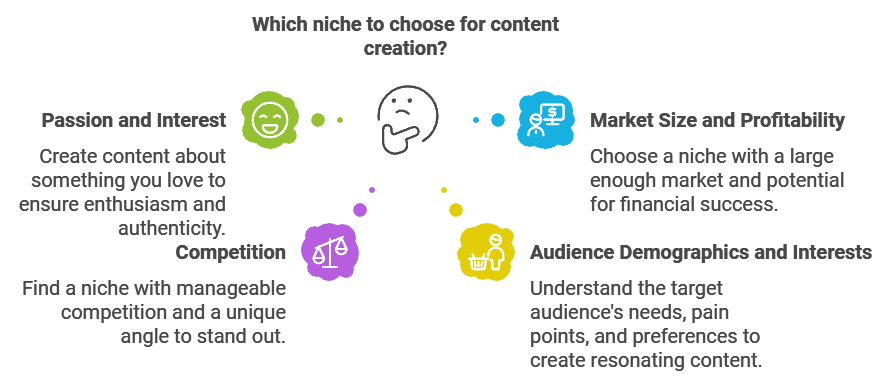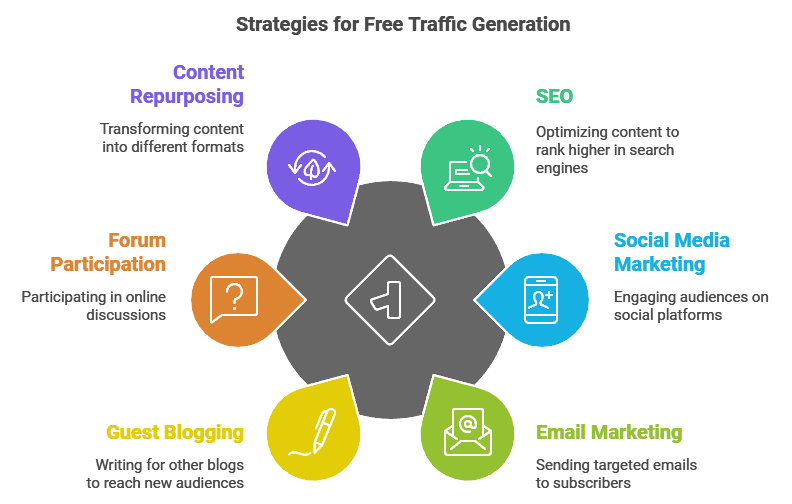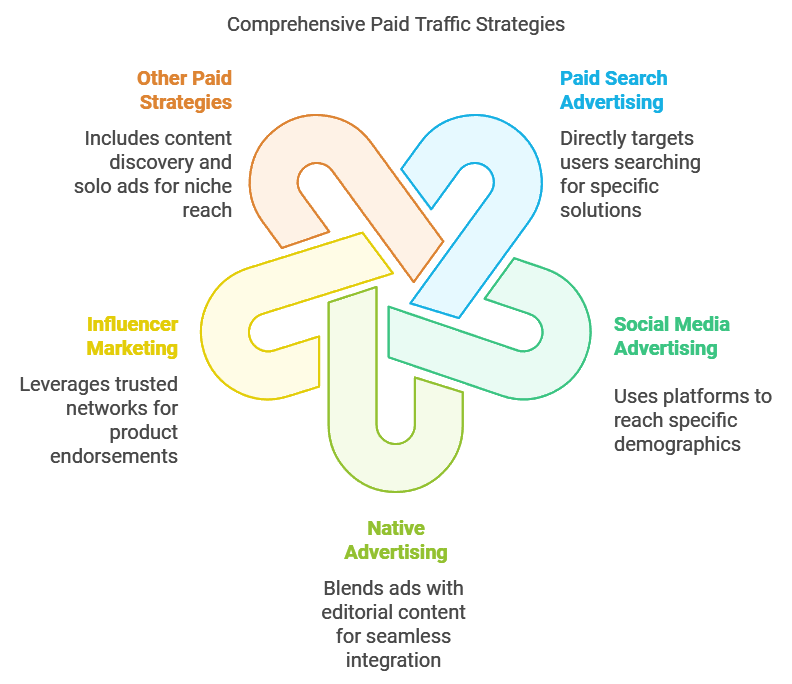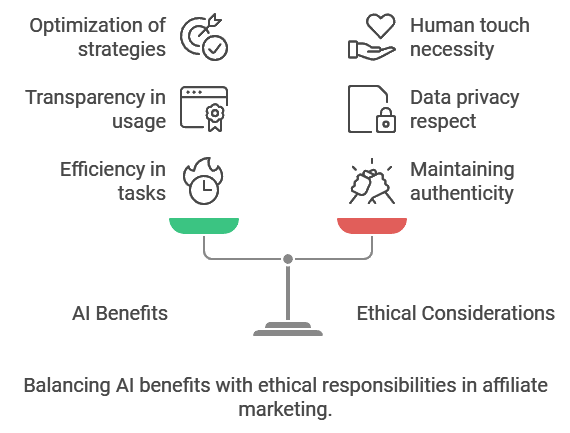I. Introduction: Traffic is the Lifeblood of Affiliate Marketing
Pay attention—if you think affiliate marketing is just about placing a few links and hoping people click, think again. Here’s a powerful fact: 78.3% of affiliate marketers use SEO as their primary traffic source (Source: Affiliate Marketing Insights Report 2023). That’s because traffic is everything. Without it, even the most well-crafted affiliate links won’t move the needle on your bottom line.
Affiliate marketing, at its core, is about connecting the right product with the right people and earning a commission for facilitating that connection. For example, if someone is passionate about fitness, they could promote gym equipment or nutritional supplements to an audience interested in staying fit and healthy. But here’s the catch—you need high-quality traffic to make it work. By high-quality traffic, I mean visitors who have purchasing intent and are genuinely interested in what you’re offering. And not just any traffic; we’re talking targeted clicks that lead to real conversions. This post is designed to do one thing: show you how to drive that traffic—the kind that actually converts into cash.
You need a strategy. You need focus. You need to know how to navigate the challenges—like the infamous “Google Sandbox” that keeps new websites stuck in limbo, struggling for visibility. But with those challenges also come huge rewards. When you get it right, you’re looking at passive income streams that can fundamentally change your lifestyle.
In this post, we’ll break down the actionable strategies that can turn your affiliate marketing from a side hustle into a main income source. No fluff, just real tactics that work. Here’s what we’ll cover: understanding your target audience, free and paid traffic strategies, leveraging AI tools, and learning from real-life case studies. Let’s get started.
Estimated reading time: 22 minutes
Looking for something else?
II. Understanding Your Target Audience and Niche
Choosing the right niche is like choosing a career—it’s a vital decision that impacts your long-term success. Just like picking a career that you love, your niche should align with something that genuinely interests you. Why? Because affiliate marketing isn’t a quick win; it takes commitment, consistency, and a ton of effort. In fact, studies show that 63% of marketers find generating traffic and leads to be their biggest challenge, but those working within a niche they are passionate about are 45% more likely to succeed. If you choose a niche that excites you, like sustainable living or fitness, you’ll be much more motivated to create quality content and engage authentically with your audience.
Here are the key factors to consider when choosing the perfect niche:
- Passion and Interest
- Market Size and Profitability
- Competition
- Audience Demographics and Interests
Passion and Interest
- You’ll be more motivated to create content when it’s about something you love. Your enthusiasm will shine through in your writing, and your audience will feel that energy. Remember, the best content is born from passion—if you’re not passionate about your niche, your audience will sense it.
Market Size and Profitability
- Is the niche large enough to support your goals? A small, highly specialized niche might have less competition, but it could also mean fewer potential customers. Make sure the market can support your financial aspirations. Ask yourself: Are people spending money in this niche? Can I find products that solve real problems for my audience? For example, the health and wellness niche is profitable because people are consistently spending on fitness programs, supplements, and equipment that address their well-being and fitness goals.
Competition
- How saturated is the niche? Competition isn’t always a bad thing—in fact, it can be proof that a niche is profitable. To evaluate if the competition is manageable, consider checking metrics like domain authority or keyword difficulty using tools like Ahrefs or Moz. However, you need to find ways to stand out. What unique angle can you bring? Maybe it’s your personal story, a specialized skill, or a unique insight that can help you differentiate from the crowd.
Audience Demographics and Interests
- Who are you trying to reach? Dive deep into the demographics, interests, and behaviors of your potential audience. What are their biggest pain points? What are they talking about in forums, Facebook groups, or other online communities? Understanding their needs will allow you to create content that resonates and drives traffic. Remember: The better you know your audience, the better you can serve them. Use surveys or engage directly through comments to understand their needs and preferences more deeply.
Tools and Resources for Niche Research
- Keyword Research Tools: Tools like Keyword Magic Tool from Semrush are your secret weapon. They help you uncover which keywords are worth targeting, what your audience is searching for, and how to align your content with their needs.
- Competitor Analysis: Identify the top affiliates in your niche and analyze their strategies. What content are they producing? How are they driving traffic? Competitor analysis isn’t about copying—it’s about learning what works and making it even better. Use tools like Ahrefs or SimilarWeb to analyze their traffic sources, content, and backlinks to get actionable insights. Prioritize the insights by focusing on high-traffic content and identifying backlink opportunities that can significantly boost your authority.
- Social Media Listening: Forums, groups, hashtags—social media is a goldmine for understanding your audience. What questions are people asking? What are their main frustrations? Use this information to position your content as the solution they’re desperately seeking.

Key Takeaways:
- Choosing a niche is about more than just what seems profitable—it’s about passion, market viability, and understanding your audience.
- Use tools like Semrush for keyword research, and analyze your competitors to see what works in your chosen niche.
- Don’t just observe your audience, engage with them. Understand their challenges and speak directly to those pain points.
Action Step: Take the time to brainstorm niches that align with your passion and validate them by researching their profitability and audience interest. The right niche is the foundation of your affiliate marketing success—get it right, and everything else will fall into place. Now, take immediate action by listing your top three niche ideas and researching their potential today.
III. Free Traffic Strategies: The Foundation of a Sustainable Business
If you want to build a sustainable affiliate business, listen up—free traffic is your foundation. The long-term benefits of focusing on free traffic channels, especially SEO, can’t be overstated. These methods might take time to show results—typically anywhere from 3 to 6 months, depending on the niche’s competitiveness and the quality of your content—but once they’re established, they can deliver consistent, high-quality traffic without constantly emptying your wallet.
A. Search Engine Optimization (SEO)
SEO is the cornerstone of most successful affiliate marketers’ strategies. Why? Because it allows you to attract users who are actively searching for solutions related to your niche—users who are already primed to convert. Here are the key components you need to focus on:
1. Keyword Research
- Finding and targeting the right keywords is critical. You need to target keywords that your audience is actively searching for. Use tools like Semrush or Ahrefs to discover high-volume, low-competition keywords that can drive relevant traffic to your site.
2. On-Page Optimization
- To rank well in search results, you need to optimize your content. This includes incorporating your target keywords into headings, meta descriptions, alt text, and naturally throughout your text. Remember, the goal is to make your content valuable for both users and search engines. Surfer SEO can help guide your on-page efforts, suggesting the best practices for keyword density, internal links, and more.
3. Content Marketing
- Content is king, and valuable, informative content will resonate with your audience. Produce content that addresses the pain points and questions your target audience has. For example, if your audience struggles with managing time effectively, create content that provides practical time management tips and tools. If they’re struggling with managing time while working on a side hustle, provide actionable strategies to simplify the process. Quality content leads to backlinks, which further improves your site’s authority and ranking.
4. Link Building
- Backlinks are like votes of confidence for your website. They signal to search engines that your site is credible and authoritative. Aim to get backlinks from reputable websites in your niche. This can be done by guest posting, reaching out to other bloggers, or creating link-worthy content that others naturally want to share. Remember, not all backlinks are created equal—focus on quality over quantity.
B. Social Media Marketing
Social media is a powerhouse for driving free traffic, especially when you use it strategically.
1. Choosing the Right Platforms for Your Niche
- Not all social platforms are created equal. Choosing the right platform depends on where your audience hangs out. Instagram and TikTok are great for niches like health, fitness, and lifestyle, whereas LinkedIn might be better suited for B2B or entrepreneurship content. In fact, LinkedIn boasts over 1 billion members globally, with more than 300 million active users each month. Notably, 61 million users are senior-level influencers, and 40 million are in decision-making positions, making it an ideal platform for reaching business professionals. Know where your audience is and focus your efforts there.
2. Creating Engaging Content Tailored to Each Platform
- Adapt your content to fit the platform. Instagram loves visuals; TikTok needs short, snappy videos; LinkedIn requires a professional yet conversational tone. Play to the strengths of each platform to get maximum engagement.
3. Building a Community and Engaging with Your Followers
- Engagement is key on social media. Respond to comments, ask questions, and start conversations. Social platforms reward engagement, and the more active your profile, the more visible it will be. Build a loyal community by showing genuine interest in your followers.
4. Leveraging Social Media for Content Distribution and Promotion
- Use social media to distribute your content. Share blog posts, product reviews, and other valuable content, and encourage your audience to share it too. A well-planned social strategy can amplify your reach and bring new visitors to your site.
C. Email Marketing
Email marketing is a goldmine for affiliate marketers, especially when done right.
1. Building an Email List
- Your email list is one of your most valuable assets. Use lead magnets—like free guides, checklists, or exclusive content—to capture email addresses. For example, offering a free ’10-Day Productivity Planner’ has been proven effective in encouraging sign-ups by providing immediate, actionable value to potential subscribers. Make sure these lead magnets provide real value so that people are eager to sign up.
2. Segmenting Your List for Targeted Campaigns
- Don’t treat your email subscribers as a single group. Segment your list based on their interests, behavior, or where they are in the buyer journey. This allows you to create targeted campaigns that resonate better with each subscriber group.
3. Providing Valuable Content and Nurturing Your Subscribers
- Deliver value first. Your emails should educate, entertain, or solve a problem for your readers. Consistent value will nurture trust, making your subscribers more likely to click on affiliate links when you do share them.
4. Strategically Incorporating Affiliate Links into Emails
- When incorporating affiliate links into your emails, it’s crucial to be transparent and ensure that the links are relevant and genuinely helpful to your audience. This approach builds trust and increases the likelihood of conversions. To manage your email campaigns effectively, consider using tools like Funnel Freedom. Funnel Freedom offers comprehensive email marketing features, including unlimited contacts and pay-as-you-go email sending options, making it a cost-effective solution for affiliate marketers.
D. Other Free Traffic Strategies
There are more ways to drive free traffic beyond SEO, social media, and email marketing.
1. Guest Blogging
- Guest blogging is an effective way to get in front of a new audience and drive traffic back to your site. Consider writing for popular sites like Medium or HubSpot, which accept guest posts and have a large, engaged audience. On Medium, opinion pieces and personal stories tend to perform well, while HubSpot prefers actionable, data-driven content that provides practical value to marketers. Write for reputable sites within your niche to establish credibility and include a link back to your content.
2. Forum Participation
- Join relevant forums and online communities where your target audience is active. Provide helpful answers and link back to your content where appropriate. This is a great way to establish yourself as an authority while driving traffic.
3. Content Repurposing
- Repurpose your blog posts into videos, infographics, or even podcasts to reach different audience segments. Content repurposing allows you to make the most out of every piece of content and extend your reach across multiple channels.

Key Takeaways:
- Free traffic strategies, especially SEO, are the backbone of a sustainable affiliate business. They may take time, but their long-term payoff is unmatched.
- Utilize social media platforms effectively by choosing those that align with your audience and creating tailored content.
- Build and nurture an email list—it remains one of the most cost-effective ways to drive traffic and conversions.
- Diversify your free traffic sources by guest blogging, participating in forums, and repurposing content.
Action Step: Start implementing one of these free traffic strategies today. Whether it’s researching keywords for SEO or creating a lead magnet for email marketing—take action now and build the foundation for long-term success.
IV. Paid Traffic Strategies: Boosting Visibility and Reach
Sometimes, you need to kick things up a notch and accelerate growth—that’s where paid traffic comes in. Unlike organic strategies, which take time to show results, paid traffic can boost your visibility and reach immediately. But, it’s essential to know when and why to consider paid traffic: when your organic growth has plateaued, when you need quick results, or when you want to scale aggressively. Paid ads are powerful tools, but they need to be used wisely, or they can drain your budget without results.
A. Paid Search Advertising (PPC)
Paid Search Advertising, like Google Ads or Bing Ads, is one of the most direct ways to get in front of people actively searching for what you offer.
1. Google Ads & Bing Ads: Targeting Keywords
- Google Ads and Bing Ads allow you to target specific keywords so that your ads show up directly in search results when users are looking for solutions you provide. It’s all about getting right in front of the customer at the exact moment they’re interested.
2. Setting a Budget and Bidding on Keywords
- Budgeting and bidding are crucial for PPC success. You have to balance getting visibility with not overspending. Tools like Google Keyword Planner help you determine the right keywords and estimate bids to stay competitive without breaking the bank.
3. Creating Compelling Ad Copy and Landing Pages
- Your ad copy needs to be compelling and concise. It must address a pain point or solution that matches the user’s search intent. For example, if you’re advertising a time management app, an effective ad could say: ‘Struggling to find time for what matters? Our app helps you regain control of your day—try it now!’ This type of copy directly addresses a common pain point while prompting immediate action. The landing page should be optimized for conversions—quick load time, a clear headline, and an easy call-to-action are essential. Remember: A good ad gets the click, but a great landing page makes the sale.
4. Tracking and Analyzing Campaign Performance
- Paid campaigns need constant monitoring. Use Google Analytics to track performance metrics like click-through rate (CTR), cost-per-click (CPC), and conversion rate. Analyze what works and refine what doesn’t—PPC isn’t set-and-forget; it’s optimize and grow.
B. Social Media Advertising
Social Media Advertising lets you target specific demographics with laser precision. Whether it’s Facebook, Instagram, or Pinterest, you can get your message in front of the people most likely to be interested in your products.
1. Facebook Ads, Instagram Ads, Pinterest Ads: Targeting Specific Demographics
- These platforms let you create highly targeted ads. Facebook’s advertising platform, for example, allows you to define your audience by demographics, interests, behavior, and more. Want to target new moms or fitness enthusiasts? Done. This level of targeting makes social media advertising particularly powerful.
2. Using Visuals and Engaging Copy to Capture Attention
- In the noisy world of social media, visuals matter. Use striking images or videos that capture attention, such as user-generated content or short testimonial videos. Combine them with engaging ad copy that speaks directly to the audience’s needs. Think bold, clear messages that prompt an action.
3. Running Retargeting Campaigns to Re-Engage Website Visitors
- Retargeting campaigns are golden opportunities. They let you serve ads to people who’ve already shown interest in your content or products. These audiences are warmer, meaning they’re more likely to convert. Use Facebook Pixel to track visitors and bring them back with offers they can’t refuse.
C. Native Advertising
Native advertising is all about blending your promotional content into the surrounding environment so it feels natural. Platforms like Outbrain and Taboola help you promote content that matches the look and feel of the platform where it’s displayed.
- Promoting Your Content on Platforms: Outbrain and Taboola allow your ads to show up as “recommended” content across major websites. These ads look like they’re part of the website, which makes people more likely to click.
- Creating Content that Blends Seamlessly: The key to native ads is ensuring your content adds value and blends in seamlessly with the editorial content around it. Think of it as a way to introduce your brand while providing useful information.
D. Influencer Marketing
Partnering with influencers can be an extremely effective paid strategy. Influencer marketing helps you tap into trusted networks that have already been built.
1. Partnering with Influencers in Your Niche
- Look for influencers whose audience aligns with your target demographic. It’s all about credibility and trust—when an influencer recommends your product, it’s a direct endorsement from someone their audience already believes in.
2. Negotiating Sponsored Posts, Product Reviews, or Affiliate Codes
- Work with influencers on sponsored posts, product reviews, or by giving them affiliate codes. Be clear about what you expect, and negotiate rates upfront. Specify the number of posts, content ownership, performance metrics, and timelines to ensure both parties have clear expectations. The goal is to ensure you’re getting genuine engagement and not just vanity metrics.
E. Other Paid Traffic Strategies
There are a few additional paid strategies that can help drive traffic quickly.
1. Content Discovery Platforms
- Platforms like Quora and Reddit offer content discovery opportunities. You can promote answers or discussions to get your brand in front of niche audiences who are already having conversations related to your industry. Be authentic—communities on these platforms can spot sales tactics a mile away.
2. Solo Ads
- Solo ads are another way to quickly expand your reach. You pay established email list owners to promote your offer to their subscribers. However, be cautious of potential risks, such as low-quality email lists or non-engaged audiences, to ensure your budget is used effectively. This can work well if the list owner’s audience matches your target demographic. Always test small first to see if their audience responds well before committing a bigger budget.

Key Takeaways:
- Paid traffic is about speed and precision. It can help boost your reach quickly but must be used thoughtfully to avoid wasting resources.
- Choose your platforms based on audience alignment—Google Ads for search intent, social media for targeted demographics, native ads for seamless brand integration, and influencers for trusted endorsements.
- Measure and refine—use analytics to track what’s working and optimize where needed.
Action Step: Evaluate your current growth stage and see where paid traffic can make the most impact. Start with a small, manageable budget, test different strategies, and scale the ones that drive the most value.
V. AI and the Future of Affiliate Marketing: A New Frontier
AI is transforming affiliate marketing. To stay competitive, you must harness its potential effectively. This isn’t the future—it’s happening right now. AI tools are reshaping how we research, create content, and engage with audiences. Adapt, or be left behind.
A. AI Tools for Affiliate Marketers
AI is more than just hype. It’s an opportunity to gain an edge over your competitors by using smart tools that work in real-time to optimize your strategies.
1. Keyword Research: Smarter and Faster
- AI-powered keyword research tools can pinpoint high-volume, low-competition keywords faster than any manual method. For example, an AI tool might identify ‘affordable home fitness equipment’ as a high-potential keyword that could be missed through manual research. Think about tools like Jasper or SurferSEO—they use machine learning to analyze trends and discover keywords you can actually rank for. This means less time spent guessing and more time hitting the target.
2. Content Creation: AI as Your Assistant, Not Your Replacement
- AI writing assistants are game-changers for affiliate marketers. With tools like ChatGPT or Copy.ai, you can generate blog posts, product descriptions, FAQ sections, and listicles quickly. But remember: AI content should always be polished by a human touch to ensure authenticity. Your audience connects with genuine, relatable stories—don’t let AI remove that.
3. Niche Discovery: Find the Unexplored Territories
- AI isn’t just about optimization; it’s about discovery. Tools like Trendspotter AI help identify emerging trends and profitable niches before they become mainstream. Imagine getting into a niche before your competitors even know it exists—that’s the power of AI-driven analysis.
4. Chatbots: Round-the-Clock Engagement
- AI chatbots can handle customer queries 24/7, creating a seamless visitor experience on your affiliate websites. Tools like Tidio can answer questions, offer product recommendations, and nudge visitors towards clicking those affiliate links. This helps you provide value at every touchpoint, without burning out.
B. Ethical Considerations of AI in Affiliate Marketing
AI can offer massive advantages, but with great power comes great responsibility. As affiliate marketers, we need to use AI ethically, ensuring transparency and authenticity.
1. Transparency: Be Upfront About AI Usage
- If you’re using AI to create content, disclose it. Your audience deserves honesty. For example, you could add a note like ‘This content was partially generated using AI tools.’ Let them know if an AI tool helped craft a blog post or product review. Transparency builds trust, and trust is the foundation of affiliate success.
2. Authenticity: Keeping the Human Touch
- AI can help with efficiency, but it should never replace the human element. Make sure your content feels personal. Add anecdotes, personal insights, and humor—things AI simply can’t replicate convincingly. People follow people, not machines.
3. Data Privacy: Respecting Your Audience’s Information
- Data privacy is non-negotiable. If you’re collecting user data through AI tools, ensure you’re compliant with all regulations, like GDPR. Treat user data as you would want your own data treated—ethically and securely. Ensure all user data is encrypted and anonymized where possible. Missteps here can not only result in fines but can also destroy your credibility.

Key Takeaways:
- AI is not just a buzzword; it’s an essential tool for staying competitive in affiliate marketing. Leverage AI for keyword research, content creation, niche discovery, and chatbots to elevate your strategy.
- Be transparent when using AI in your content creation. Authenticity and trust are more critical than speed.
- Always prioritize data privacy. Respect your audience’s information, and stay compliant with regulations to build lasting trust.
Action Step: Start incorporating one AI tool into your affiliate strategy today. Whether it’s for keyword research, content creation, or engaging with visitors—choose one and implement it. The sooner you adapt, the sooner you start gaining the edge.
VI. Case Studies: Learning from Successful Affiliates
There’s no better way to understand what works in affiliate marketing than by examining the success stories of those who have already made it big. These real-world case studies showcase different approaches to driving traffic, including SEO, PPC, and content marketing, and turning it into significant revenue. Let’s dive into a few standout examples of effective affiliate strategies and explore the takeaways you can apply to your own business.
1. Contentellect’s SEO Strategy: The Power of Long-Form Content
Contentellect exemplifies how to harness the power of SEO and content marketing for affiliate growth. They focused on creating high-quality, long-form content, which allowed them to see a significant return on investment. Here’s how they did it:
- Developed a comprehensive content plan producing 50,000 words of commercial content, including product-focused articles and buying guides.
- Experimented with new link types and partnerships based on real-time performance data.
- Leveraged an aged and high-quality domain paired with a smart site structure to boost SEO.
Results: Within two years, Contentellect turned a $0 content page into a $10,000 monthly revenue stream, achieving an impressive 410% ROI. Their consistent adaptation and performance-based tweaks allowed them to capitalize on their content efforts.
Takeaway: A solid content plan with long-form, SEO-optimized content can lead to significant traffic and revenue over time. Experimentation is key—be willing to try new link-building strategies and partnerships to find what works best for your audience.
2. Wirecutter’s Product Review Expertise: Building Trust Through Authority
Wirecutter, now owned by The New York Times, set the standard for affiliate marketing through in-depth product reviews. Their strategy focuses on creating expert, detailed reviews for products they’ve personally tested, such as laptops and kitchen appliances, which not only builds audience trust but also enhances conversion rates.
- Concentrated on in-depth reviews for everyday products, from household items to electronics.
- Leveraged genuine product testing and expert recommendations to strengthen credibility with their audience.
Results: Between 2011 and 2016, Wirecutter generated $150 million in revenue, largely driven by their transparent, research-backed content before being acquired by The New York Times.
Takeaway: If you can establish yourself as an authority in your niche, by providing genuine, expert insights, your audience is more likely to trust your recommendations. Transparency and real experience go a long way in driving conversions.
3. Skyscanner’s Blog Integration: Complementing the Core Business with SEO
Skyscanner utilizes a clever blend of SEO and content marketing through their travel blog to funnel organic traffic into their main offering—travel price comparison.
- Created SEO-driven travel guides that naturally directed readers to use their travel search tool.
- Tapped into their own affiliate program, using platforms like Commission Junction to monetize effectively.
Results: Skyscanner’s travel blog significantly increased site traffic and affiliate revenue, establishing them as a trusted resource in the travel niche.
Takeaway: A well-placed blog can be a game-changer. Creating SEO-optimized, informative content that complements your core service can boost traffic and credibility, turning casual readers into paying users.
4. Aynur Talgaev’s Niche PPC Campaign: Nailing Paid Traffic with Precision
Aynur Talgaev managed to target a niche audience using PPC advertising to generate exceptional affiliate returns. His success came from a deep understanding of market dynamics and focusing on less competitive regions.
- Targeted the Romanian market to promote a niche product, overcoming strict advertising restrictions.
- Spent only $110 on traffic acquisition, while continually refining his strategies through data analysis, including metrics like click-through rates and audience demographics.
Results: Aynur achieved $16,000 in commissions from just one product, with a conversion rate of around 2.5%. This demonstrates that smart targeting and a data-driven approach can yield impressive results.
Takeaway: Sometimes less competitive markets can be gold mines for affiliate marketers. With strategic spending and constant analysis, you can gain a considerable edge—even with a modest budget.
5. Pharma Affiliate Marketing with Facebook Ads: Using Paid Social to Scale Quickly
One affiliate marketer focused on promoting pharmaceutical offers using Facebook Ads in the Romanian market. By creatively circumventing challenges, they achieved significant growth in both reach and revenue.
- Created teaser-style ad creatives that resonated with the target audience.
- Employed cloakers and proxies (tools used to hide certain parts of web traffic and protect privacy) to ensure compliance with Facebook’s strict advertising policies.
Results: In six months, they generated over $23,800 in revenue from 1,591 approved leads, achieving an ROI of around 200% during peak months.
Takeaway: With paid social ads, particularly Facebook Ads, creative approaches and understanding platform rules can allow for rapid growth. Knowing how to navigate restrictions is key to scaling paid traffic effectively.
Key Takeaways from Case Studies
- Content is King: Contentellect’s long-form SEO strategy shows the value of having detailed, high-quality content tailored to your audience’s needs.
- Build Trust with Transparency: Wirecutter proves that honesty and expert reviews make a significant impact, leading to higher conversion rates.
- Integrate and Leverage SEO: Skyscanner’s travel guides seamlessly complement their main service, showcasing the potential of combining a blog with affiliate offers.
- Target Niche Markets: Aynur Talgaev’s success highlights that sometimes the best opportunities are in niche, less competitive markets.
- Scale Fast with Paid Ads: The Pharma Facebook Ads case study reveals the importance of creativity and compliance in scaling quickly through paid channels.
Action Step: Review these case studies and identify one or two strategies that align with your goals. Whether it’s SEO-driven content, PPC advertising, or building trust with in-depth reviews—pick a tactic and start testing it today. Success comes from applying what you learn and adapting it to fit your unique audience and offerings.
VII. Conclusion: Building a Sustainable Affiliate Marketing Business
We’ve covered a lot of ground in this post, diving into the various strategies that successful affiliate marketers use to drive traffic and generate revenue. These strategies include SEO-driven content creation, PPC campaigns, in-depth product reviews, and targeted social media ads. A diverse mix of traffic sources is essential for building a sustainable affiliate marketing business. Whether it’s SEO-driven content creation, PPC campaigns, in-depth product reviews, or targeted social media ads, leveraging multiple strategies ensures a resilient and lasting approach.
Recap and Long-Term Strategy
One of the main themes we’ve explored is the importance of a long-term strategy. Relying on just one traffic source can be risky; instead, combining multiple sources—like organic search, paid ads, and content marketing—provides a more resilient and robust approach. The case studies we discussed showed how different methods can work in harmony to create significant, lasting results.
Successful affiliates experiment constantly. They’re always testing new tactics, whether it’s trying out a new PPC campaign, optimizing on-page SEO, or developing fresh content to address evolving audience needs. For instance, one affiliate found that experimenting with video content on social media increased engagement by 30%, leading to higher conversion rates. Continuous learning and adaptation are the bedrock of success in affiliate marketing.
Take Action: Start Your Affiliate Journey Today
The only way to succeed is to start. Begin by applying one or two of the strategies we’ve discussed here. Whether it’s improving your SEO game, diving into paid ads, or creating trust-building product reviews—take a step today. The journey to building a sustainable affiliate marketing business doesn’t happen overnight, but with perseverance and the right tools, you can achieve it. Remember, even the most successful marketers started from scratch—consistency is key, and the rewards are worth every effort.
To help you get started, I’m offering my free course: Mapping Your 9 to 5 Exit Strategy – How This Unfair Software Clones a 7-Figure Business in Seconds. If you’re serious about leaving your 9 to 5 and making affiliate marketing your full-time income, this course is the perfect place to begin.
Join My Free Course Now and start building the future you’ve always dreamed of.
Additional Resources for Your Success
If you want to go even deeper, check out these resources that will give you even more insights into driving traffic effectively:
- Free Traffic Sources for Affiliate Marketing – WeCanTrack
- How to Drive Traffic to Affiliate Links – Guru
These articles will expand on the topics we’ve covered here and help you continue building your knowledge. Consider revisiting these resources regularly or setting aside time each week for continuous learning to stay ahead in your affiliate journey.Remember: The path to affiliate success is paved with action, learning, and adaptation. Take the insights from this guide, apply them, and watch your affiliate marketing business grow. You’ve got this!










Leave a Reply